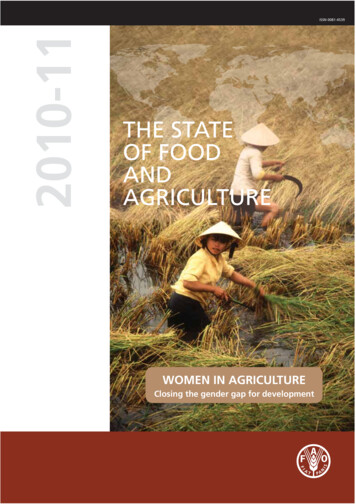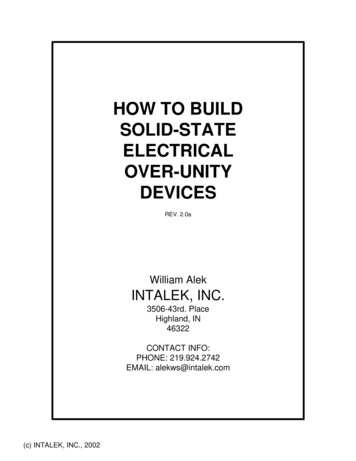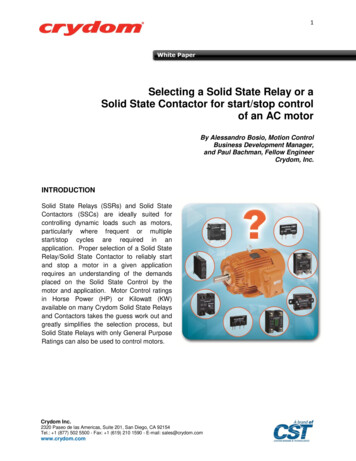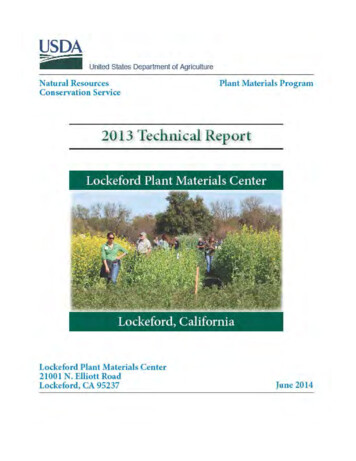
Transcription
2010-11ISSN 0081-4539THE STATEOF FOODANDAGRICULTUREWOMEN IN AGRICULTUREClosing the gender gap for development
Photos on front cover and page 3: All photos are from the FAO Mediabase.Copies of FAO publications can be requested from:SALES AND MARKETING GROUPOffice of Knowledge Exchange, Research and ExtensionFood and Agriculture Organization of the United NationsViale delle Terme di Caracalla00153 Rome, ItalyE-mail: publications-sales@fao.orgFax: ( 39) 06 57053360Web site: http://www.fao.org/catalog/inter-e.htm
2010-11ISSN 0081-4539THE STATEOF FOODANDAGRICULTUREFOOD AND AGRICULTURE ORGANIZATION OF THE UNITED NATIONSRome, 2011
The designations employed and the presentation of material in thisinformation product do not imply the expression of any opinion whatsoeveron the part of the Food and Agriculture Organization of the United Nations (FAO)concerning the legal or development status of any country, territory,city or area or of its authorities, or concerning the delimitation of its frontiersor boundaries. The mention of specific companies or productsof manufacturers, whether or not these have been patented, does not implythat these have been endorsed or recommended by FAO in preferenceto others of a similar nature that are not mentioned.The designations employed and the presentation of material in the map does not implythe expression of any opinion whatsoever on the part of FAO concerning the legal orconstitutional status of any country, territory or sea area, or concerning the delimitationof frontiers.ISBN 978-92-5-106768-0All rights reserved. Reproduction and dissemination of material in this informationproduct for educational or other non-commercial purposes are authorized withoutany prior written permission from the copyright holders provided the source is fullyacknowledged. Reproduction of material in this information product for resale or othercommercial purposes is prohibited without written permission of the copyright holders.Applications for such permission should be addressed to:ChiefElectronic Publishing Policy and Support BranchOffice of Knowledge Exchange, Research and ExtensionFAOViale delle Terme di Caracalla, 00153 Rome, Italyor by e-mail to:copyright@fao.org FAO 2011
iiiContentsForewordAcknowledgementsAbbreviations and acronymsPart IWomen in agriculture: closing the gender gap for developmentviviiix11. The gender gap in agricultureStructure of the report and key messagesKey messages of the report2. Women’s workWomen in agricultureWomen in rural labour marketsKey messages3. Documenting the gender gap in agricultureLandLivestockFarm labourEducationInformation and extensionFinancial servicesTechnologyKey messages4. Gains from closing the gender gapProductivity of male and female farmersProduction gains from closing the gender gapOther social and economic benefits of closing the gender gapKey messages5. Closing the gender gap in agriculture and rural employmentClosing the gap in access to landClosing the gap in rural labour marketsClosing the financial services gapClosing the gap in social capital through women’s groupsClosing the technology gapKey messages6. Closing the gender gap for 46495153565861Part IIWorld food and agriculture in review63Trends in undernourishmentFood production, consumption and trade during the crisesRecent trends in agricultural prices: a higher price plateau, and greater price volatilityConclusions65687681
ivPART IIIStatistical annex83Notes on the Annex tables85TABLE A1 Total population, female share of population and rural share of populationin 1980, 1995 and 201090TABLE A2 Female share of national, rural and urban population aged 15–49,most recent and earliest observations97TABLE A3 Economically active population, female share of economically activepopulation and agricultural share of economically active womenin 1980, 1995 and 2010104TABLE A4 Economically active population, agricultural share of economically activepopulation and female share of economically active in agriculturein 1980, 1995 and 2010111TABLE A5 Share of households in rural areas that are female-headed, most recentand earliest observations, and total agricultural holders and female share118of agricultural holders, most recent observationsTable A6 Share of adult population with chronic energy deficiency (CED – body massindex less than 18.5) by sex and share of children underweight by sex,residence and household wealth quintile, most recent observations125ReferencesSpecial chapters of The State of Food and Agriculture135146TABLES1.2.Employment in selected high-value agro-industriesSelected examples of health insurance products targeted towards women2152Sex versus genderFrequently asked questions about women in agricultureWomen and unpaid household responsibilitiesFemale farmers, household heads and data limitationsLabour productivity and hunger, nutrition and healthWomen in agricultural higher education and research in AfricaSmallholder coffee production and marketing in UgandaTargeting transfer payments to women for social benefitsMama Lus Frut: working together for changeIndia’s Self Employed Women’s Association (SEWA)Women in a sustainable rural livelihoods programme in UgandaFood emergenciesImplied volatility as a measure of uncertaintyPrice volatility and FAO’s Intergovernmental Groups on Grains and .9.10.11.12.13.14.
18.19.20.21.22.23.24.25.26.27.28.29.30.31.Female share of the agricultural labour forceProportion of labour in all agricultural activities that is supplied by womenProportion of labour for selected crops that is supplied by womenEmployment by sectorParticipation in rural wage employment, by genderConditions of employment in rural wage employment, by genderWage gap between men and women in urban and rural areasShare of male and female agricultural holders in main developing regionsRural household assets: farm sizeHousehold livestock assets, in male- and female-headed householdsEducation of male and female rural household headsGender differences in rural primary education attendance ratesCredit use by female- and male-headed households in rural areasFertilizer use by female- and male-headed householdsMechanical equipment use by female- and male-headed householdsCereal yield and gender inequalityNumber of undernourished people in the world, 1969–71 to 2010Proportion of population that is undernourished in developing regions,1969–71 to 2010Number of undernourished people in 2010, by regionFAO Food Price Index in real terms, 1961–2010Average annual percentage change in GDP per capita at constant prices, 2005–2010Annual growth in global food production, consumption and trade, 2006–2010Indices of per capita food consumption by geographic region, 2000–10Indices of food production by economic groupIndices of food production by region, 2000–10Indices of food export volumes by geographic region, 2000–10Indices of food import volumes by geographic region, 2000–10FAO Food Price Index and indices of other commodities (fruits, beverages andraw materials), October 2000–October 2010Indices of prices of commodities included in the FAO Food Price Index (cereals,oils, dairy, meat and sugar), October 2000–October 2010Historic annualized volatility of international grain pricesCo-movement of energy production costs: ethanol from maize versus petrolfrom crude oil, October 2006–October 7374757576777880
viForewordThis edition of The State of Food andAgriculture addresses Women in agriculture:closing the gender gap for development.The agriculture sector is underperforming inmany developing countries, and one of thekey reasons is that women do not have equalaccess to the resources and opportunitiesthey need to be more productive. Thisreport clearly confirms that the MillenniumDevelopment Goals on gender equality(MDG 3) and poverty and food security(MDG 1) are mutually reinforcing. We mustpromote gender equality and empowerwomen in agriculture to win, sustainably, thefight against hunger and extreme poverty.I firmly believe that achieving MDG 3 canhelp us achieve MDG 1.Women make crucial contributions inagriculture and rural enterprises in alldeveloping country regions, as farmers,workers and entrepreneurs. Their roles varyacross regions but, everywhere, women facegender-specific constraints that reduce theirproductivity and limit their contributionsto agricultural production, economicgrowth and the well-being of their families,communities and countries.Women face a serious gender gap inaccess to productive resources. Womencontrol less land than men and the landthey control is often of poorer quality andtheir tenure is insecure. Women own fewerof the working animals needed in farming.They also frequently do not control theincome from the typically small animals theymanage. Women farmers are less likely thanmen to use modern inputs such as improvedseeds, fertilizers, pest control measures andmechanical tools. They also use less credit andoften do not control the credit they obtain.Finally, women have less education and lessaccess to extension services, which make itmore difficult to gain access to and use someof the other resources, such as land, creditand fertilizer. These factors also preventwomen from adopting new technologies asreadily as men do. The constraints womenface are often interrelated and need to beaddressed holistically.The obstacles that confront womenfarmers mean that they achieve lower yieldsthan their male counterparts. Yet women areas good at farming as men. Solid empiricalevidence shows that if women farmers usedthe same level of resources as men on theland they farm, they would achieve the sameyield levels. The yield gap between men andwomen averages around 20–30 percent,and most research finds that the gap is dueto differences in resource use. Bringingyields on the land farmed by womenup to the levels achieved by men wouldincrease agricultural output in developingcountries between 2.5 and 4 percent.Increasing production by this amount couldreduce the number of undernourishedpeople in the world in the order of12–17 percent. According to FAO’s latestestimates, 925 million people are currentlyundernourished. Closing the gender gap inagricultural yields could bring that numberdown by as much as 100–150 million people.These direct improvements in agriculturaloutput and food security are just one part ofthe significant gains that could be achievedby ensuring that women have equal accessto resources and opportunities. Closingthe gender gap in agriculture would putmore resources in the hands of women andstrengthen their voice within the household– a proven strategy for enhancing the foodsecurity, nutrition, education and health ofchildren. And better fed, healthier childrenlearn better and become more productivecitizens. The benefits would span generationsand pay large dividends in the future.The gender gap is manifest in other ways.Gender relations are social phenomenaand it is impossible to separate women’seconomic spheres from their householdactivities. Preparing food and collectingfirewood and water are time-consuming andbinding constraints that must be addressedif women are to be able to spend their timein more rewarding and more productiveways. Interventions must consider womenwithin their family and community contexts.Making rural labour markets function better,
viiproviding labour-saving technologies andpublic goods and services, would enablewomen to contribute more effectively to,and benefit more fully from, the economicopportunities offered by agriculturalgrowth.There exists no blueprint for closing thegender gap in agriculture, as a wide rangeof inputs, assets, services and markets areinvolved and the related constraints areinterlinked. But with appropriate policiesbased on accurate information and analysis,progress can be made and the benefitswould be significant. The basic principlesare clear. We must eliminate all forms ofdiscrimination against women under thelaw, ensure that access to resources is moreequal and that agricultural policies andprogrammes are gender-aware, and makewomen’s voices heard in decision-makingat all levels. Women must be seen as equalpartners in sustainable development.Achieving gender equality and empoweringwomen is not only the right thing to do; it isalso crucial for agricultural development andfood security.Jacques DioufFAO DIRECTOR-GENERAL
viiiAcknowledgementsThe State of Food and Agriculture 2010–11was prepared by members of the Economicand Social Development Department ofFAO under the overall leadership of HafezGhanem, Assistant Director-General, andKostas Stamoulis, Director of the AgriculturalDevelopment Economics Division (ESA).Additional guidance was provided by MarcelaVillarreal, Director, and Eve Crowley, PrincipalAdviser, of the Gender, Equity and RuralEmployment Division (ESW); Pietro Gennari,Director, Statistics Division (ESS); DavidHallam, Director, Trade and Markets Division(EST); and Keith Wiebe, Principal Officer, ESA.The research and writing team for Part Iwas led by Terri Raney, André Croppenstedtand Gustavo Anríquez and included SarahLowder, Ira Matuschke and Jakob Skoet(ESA). Additional inputs were providedby Luisa Cruz, Ana Paula de la O Campos,Stefano Gerosa, Yasmeen Khwaja, FaithNilsson and Panagiotis Karfakis (ESA);Francesca Dalla Valle, Soline de Villard,Caroline Dookie, John Curry, Zoraida Garcia,Denis Herbel, Regina Laub, Maria Lee,Yianna Lambrou, Marta Osorio, HajnalkaPetrics, Gabriel Rugalema, Libor Stloukal,Sophie Treinen and Peter Wobst (ESW);Magdalena Blum (FAO Office of KnowledgeExchange, Research and Extension); HolgerMatthey (EST); Anni McLeod and FraukeKramer (FAO Animal Production and HealthDivision); Helga Josupeit, Rebecca Metznerand Stefania Vannuccini (FAO Fisheriesand Aquaculture Policy and EconomicDivision); Robert Mayo (ESS) and DianaTempelman (FAO Regional Office for Africa).Ines Smyth (Oxfam), Cathy Farnworth (onbehalf of IFAD), Elisenda Estruch (ESW)and Julian Thomas and Frank Mischler(ESA) provided valuable comments. We arealso grateful to Amy Heyman who read,commented and edited the first draft ofthe report. The report was prepared inclose collaboration with Agnes Quisumbingand Ruth Meinzen-Dick of IFPRI and CherylDoss of Yale University. Background papers,partially funded by ESW, were prepared byCheryl Doss; Julia Behrman, Andrew Dillon,Ruth Vargas Hill, Ephraim Nkonya, AmberPeterman, Esteban J. Quiñones and AgnesQuisumbing, (IFPRI); Christopher Coles, PriyaDeshingkar, Rebecca Holmes, Nicola Jones,Jonathan Mitchell and Marcella Vigneri(ODI); Diana Fletschner (Rural DevelopmentInstitute) and Lisa Kenney (University ofWashington); Christine Okali (Universityof East Anglia); Jan Lundius (independentconsultant); and Holger Seebens (KfWEntwicklungsbank). Additional backgroundpapers were prepared by the following FAOstaff members: Gustavo Anríquez, YasmeenKhwaja, Lucia Palombi (FAO EmergencyOperations and Rehabilitation Division) andPaola Termine (ESW). The report also drewon papers prepared for the FAO-IFAD-ILOWorkshop on Gender and Rural Employmentand synthesized by Soline de Villard andJennie Dey de Pryck. The report benefitedfrom two expert consultations, partiallyfunded by the World Bank. In addition tomany of those mentioned above, externalparticipants included Isatou Jallow (WFP),Johannes Jütting (OECD), Patricia BiermayrJenzano (CIAT), Markus Goldstein andEija Pehu (World Bank), Maria Hartl andAnnina Lubbock (IFAD), Jemima Njuki (ILRI),Thelma Paris (IRRI), Patrick Webb (TuftsUniversity), and Manfred Zeller (University ofHohenheim). Hela Kochbati (Afard), RobertMazur (Iowa State University) and othersmade valuable contributions to the GlobalForum on Food Security and Nutrition (FSNForum) on Women in Agriculture, organizedby Max Blanck and Renata Mirulla (ESA).We are grateful for many useful commentsreceived at a mini-symposium organized atthe International Association of AgriculturalEconomists Triennial Conference.In addition, the final draft report wasreviewed by Patrick Webb (Tufts University),Diana Fletschner (Rural DevelopmentInstitute), Thomas P. Thompson (IFDC),Maria Hartl (IFAD), Carmen Diana Deere(UCLA), Susana Lastarria-Corhiel (Universityof Wisconsin), Jo Swinnen (University ofLeuven), Patricia Biermayr-Jenzano, JoanneSandler and colleagues (UNIFEM), Barbara
ixStocking (Oxfam GB), Paul Munro-Faureand Paul Mathieu (FAO Climate, Energy andTenure Division), Ruth Meinzen-Dick (IFPRI),Agnes Quisumbing (IFPRI), and Cheryl Doss(Yale University). The writing team is mostgrateful to the workshop participants andother internal and external reviewers ofvarious drafts of the manuscript.Part II of the report was jointly authoredby Sarah Lowder (ESA) and Holger Mattheyand Merritt Cluff (EST), under the guidanceof Jakob Skoet. Additional inputs wereprovided by Joshua Dewbre and Kisan Gunjal(EST).Part III of the report was prepared bySarah Lowder, with assistance from BrianCarisma and Stefano Gerosa, under theguidance of Terri Raney. Helpful commentswere provided by Naman Keita, SeevalingumRamasawmy, Mukesh Srivastava, and FrancoStefanelli (ESS); Diana Tempelman; MariaAdelaide D’Arcangelo, Zoraida Garcia andClara Park (ESW), and Barbara Burlingameand Marie-Claude Dop (FAO Nutrition andConsumer Protection Division).The publication was greatly enhancedby Michelle Kendrick (ESA) who providedEnglish editorial and project managementsupport. Liliana Maldonado and Paoladi Santo (ESA) provided excellentadministrative support throughout theprocess. Translations and printing serviceswere provided by the Meeting Programmingand Documentation Service of the FAOCorporate Services, Human Resources andFinance Department. Graphic, layout andproofing services were provided by FloraDicarlo and Visiontime.
xAbbreviations and acronymsCEDchronic energy deficiencyCIATInternational Centre for Tropical AgricultureFFSFarmer field schoolFPIFood Price Index (FAO)ICTsinformation and communication technologiesIFADInternational Fund for Agricultural DevelopmentIFDCInternational Fertilizer Development CenterIFPRIInternational Food Policy Research InstituteILRIInternational Livestock Research InstituteIMFInternational Monetary FundLSMSLiving Standards Measurement StudyMDGMillennium Development GoalNGOsnon-governmental organizationsNREGANational Rural Employment Guarantee Act (India)ODIOverseas Development Institute (United Kingdom)OECDOrganisation for Economic Co-operation and DevelopmentRIGARural Income Generating ActivitiesSIGISocial Institutions and Gender InequalityUCLAUniversity of California, Los Angeles (United States of America)UNDPUnited Nations Development ProgrammeUNIFEMUnited Nations Development Fund for WomenWFPWorld Food Programme
Part IWOMENIN AGRICULTUREClosing the gender gap for development
Part I
W O M E N I N A G R I C U L T U R E : C losi n g t h e ge n de r g a p fo r de v elop m e n t1. The gender gap in agricultureAgriculture is underperforming in manydeveloping countries for a number ofreasons. Among these is the fact that womenlack the resources and opportunities theyneed to make the most productive use oftheir time. Women are farmers, workersand entrepreneurs, but almost everywherethey face more severe constraints thanmen in accessing productive resources,markets and services. This “gender gap”hinders their productivity and reduces theircontributions to the agriculture sector and tothe achievement of broader economic andsocial development goals. Closing the gendergap in agriculture would produce significantgains for society by increasing agriculturalproductivity, reducing poverty and hungerand promoting economic growth.Governments, donors and developmentpractitioners now recognize that agricultureis central to economic growth and foodsecurity – particularly in countries where asignificant share of the population dependson the sector – but their commitment togender equality in agriculture is less robust.Gender issues are now mentioned in mostnational and regional agricultural andfood-security policy plans, but they areusually relegated to separate chapters onwomen rather than treated as an integralpart of policy and programming. Manyagricultural policy and project documentsstill fail to consider basic questions about thedifferences in the resources available to menand women, their roles and the constraintsthey face – and how these differences mightbe relevant to the proposed intervention.As a result, it is often assumed thatinterventions in areas such as technology,infrastructure and market access have thesame impacts on men and women, when infact they may not.At the same time, building a genderperspective into agricultural policies andprojects has been made to seem moredifficult and complex than it need be.Clarification of what is meant by gender is agood place to start (Box 1).The last sentence in Box 1 also gives roomfor hope: gender roles can change. It is thegoal of this report that it will contribute toimproving understanding so that appropriatepolicies can help foster gender equality,even as agriculture itself is changing.The agriculture sector is becoming moretechnologically sophisticated, commerciallyoriented and globally integrated; at thesame time, migration patterns and climatevariability are changing the rural landscapeacross the developing world. These forcespose challenges and present opportunities forall agricultural producers, but women faceadditional legal and social barriers that limittheir ability to adapt to and benefit fromchange. Governments and donors have mademajor commitments aimed at revitalizingagriculture in developing regions, but theirefforts in agriculture will yield better resultsmore quickly if they maximize the productivepotential of women by promoting genderequality.Women, like men, can be considered“productive resources”, but they are alsocitizens who have an equal claim with men3
4TH E S TAT E O F F O O D AN D A G R I C U L T U R E 2 0 1 0 – 1 1BOX 1Sex versus genderThe concepts of “sex” and “gender”can be confusing, not least becauseeven the experts sometimes use theminconsistently. Sex refers to the innatebiological categories of male or female.Gender refers to the social roles andidentities associated with what it meansto be a man or a woman. Gender roles areshaped by ideological, religious, ethnic,economic and cultural factors and are akey determinant of the distribution ofresponsibilities and resources betweenon the protections, opportunities andservices provided by their governmentsand the international community. Genderequality is a Millennium Development Goal(MDG) in its own right, and it is directlyrelated to the achievement of the MDGtargets on reducing extreme poverty andhunger. Clear synergies exist between thegender-equality and hunger-reduction goals.Agricultural policy-makers and developmentpractitioners have an obligation to ensurethat women are able to participate fully in,and benefit from, the process of agriculturaldevelopment. At the same time, promotinggender equality in agriculture can helpreduce extreme poverty and hunger. Equalityfor women would be good for agriculturaldevelopment, and agricultural developmentshould also be good for women.The roles and status of women inagriculture and rural areas vary widelyby region, age, ethnicity and social classand are changing rapidly in some partsof the world. Policy-makers, donors anddevelopment practitioners need informationand analysis that reflect the diversity of thecontributions women make and the specificchallenges they are confronted with in orderto make gender-aware decisions about thesector.Despite the diversity in the roles andstatus of women in agriculture, the evidenceand analysis presented in this report confirmthat women face a surprisingly consistentgender gap in access to productive assets,inputs and services. A large body ofmen and women (Moser, 1989). Beingsocially determined, however, thisdistribution can be changed throughconscious social action, including publicpolicy. Every society is marked by genderdifferences, but these vary widely byculture and can change dramatically overtime. Sex is biology. Gender is sociology.Sex is fixed. Gender roles change.Source: Quisumbing, 1996.empirical evidence from many differentcountries shows that female farmers are justas efficient as their male counterparts, butthey have less land and use fewer inputs, sothey produce less. The potential gains thatcould be achieved by closing the gendergap in input use are estimated in this reportin terms of agricultural yields, agriculturalproduction, food security and broaderaspects of economic and social welfare.Because many of the constraints faced bywomen are socially determined, they canchange. What is more, external pressuresoften serve as a catalyst for women to takeon new roles and responsibilities that canimprove their productivity and raise theirstatus within households and communities.For example, the growth of modern supplychains for high-value agricultural productsis creating significant opportunities – andchallenges – for women in on-farm and offfarm employment. Other forces for socialand economic change can also translate intoopportunities for women.Gender-aware policy support and welldesigned development projects can helpclose the gender gap. Given existinginequities, it is not enough that policies begender-neutral; overcoming the constraintsfaced by women requires much more.Reforms aimed at eliminating discriminationand promoting equal access to productiveresources can help ensure that women – andmen – are equally prepared to cope withthe challenges and to take advantage ofthe opportunities arising from the changes
W O M E N I N A G R I C U L T U R E : C losi n g t h e ge n de r g a p fo r de v elop m e n tshaping the rural economy. Closing thegender gap in agriculture will benefitwomen, the agriculture and rural sectors,and society as a whole. The gains will varywidely according to local circumstances, butthey are likely to be greater where womenare more involved in agriculture and face themost severe constraints.While it seems obvious that closing thegender gap would be beneficial, evidenceto substantiate this potential has beenlacking. This edition of The State of Foodand Agriculture has several goals: to bringthe best available empirical evidence tobear on the contributions women make andthe constraints they face in agricultural andrural enterprises in different regions of theworld; to demonstrate how the gender gaplimits agricultural productivity, economicdevelopment and human well-being; toevaluate critically interventions aimed atreducing the gender gap and to recommendpractical steps that national governmentsand the international community can taketo promote agricultural development byempowering women.Structure of the report and keymessagesChapter 2 provides a survey of the rolesand status of women in agriculture andrural areas in different parts of the world.It brings the best, most comprehensiveavailable evidence to bear on a numberof controversial questions that are bothconceptually and empirically challenging.It focuses on women’s contributionsas farmers and agricultural workersand examines their status in terms ofpoverty, hunger and nutrition, and ruraldemographics. It also looks at the ways inwhich the transformation of agriculture andthe emergence of high-value marketingchains are creating challenges andopportunities for women.Chapter 3 documents the constraintsfacing women in agriculture across a rangeof assets: land, livestock, farm labour,education, extension services, financialservices and technology.Chapter 4 surveys the economic evidenceon the productivity of male and femalefarmers and estimates the gains that couldbe achieved by closing the gender gap inagricultural input use. Potential gains inagricultural yields, agricultural production,food security and broader aspects ofeconomic and social welfare are assessed.Chapter 5 advances specific policies andprogrammes that can help close the gendergap in agriculture and rural employment.The focus is on interventions that alleviateconstraints on agricultural productivity andrural development.Chapter 6 provides broaderrecommendations for closing the gender gapfor development.Key messages of the report Women make essential contributions toagriculture in developing countries, buttheir roles differ significantly by regionand are changing rapidly in some areas.Women comprise, on average, 43 percentof the agricultural labour force indeveloping countries, ranging from20 percent in Latin America to 50 percentin Eastern Asia and sub-Saharan Africa.Their contribution to agricultural workvaries even more widely depending onthe specific crop and activity. Women in agriculture and rural areashave one thing in common acrossregions: they have less access thanmen to productive resources andopportunities. The gender gap is foundfor many assets, inputs and services– land, livestock, labour, education,extension and financial services, andtechnology – and it imposes costs on theagriculture sector, the broader economyand society as well as on womenthemselves. Closing the gender gap in agriculturewould generate significant gains forthe agriculture sector and for society.If women had the same access toproductive resources as men, theycould increase yields on their farms by20–30 percent. This could raise totalagricultural output in developingcountries by 2.5–4 percent, which couldin turn reduce the number of hungrypeople in the world by 12–17 percent.5
6TH E S TAT E O F F O O D AN D A G R I C U L T U R E 2 0 1 0 – 1 1The potential gains would vary by regiondepending on how many women arecurrently engaged in agriculture, howmuch production or land they control,and how wide a gender gap
Closing the gap in access to land 46 Closing the gap in rural labour markets 49 Closing the financial services gap 51 . 20. FAO Food Price Index in real terms, 1961-2010 68 21. Average annual percentage change in GDP per capita at constant prices, 2005-2010 69 22. Annual growth in global food production, consumption and trade, 2006-2010 72











